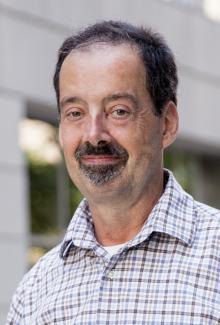VPF Point Person: Michael Yeates
When a new piece of capital equipment arrives on campus, the lab purchasing the equipment can expect a visit from VPF Property Auditor Michael Yeates within days of its arrival, often while the boxes and packing materials are still out in the hall.

Making his rounds to campus laboratories to inventory recently purchased equipment, Yeates notes the precise location of the new item, applies an MIT Property tag, updates the eProp database, and quietly moves on to the next lab on his list. Accounting for and tagging new equipment is an ongoing activity of the VPF Property Office, which in fiscal year 2016 tagged 5,369 pieces of new equipment, valued at $65.3 million.
“Visiting MIT’s labs is perhaps the most interesting part of my job,” says Yeates, a 17-year veteran of the VPF Property Office. “I try to make my visit short, so as to not disrupt the PIs and students. Even though they are immersed in their experiments, they always welcome me in and appreciate my efforts to help MIT keep track of their equipment.”
Today Yeates is busy tracking the newest items on campus, but his first job at MIT was deeply anchored in the past. In 1974, Yeates was studying history at Northeastern University when a co-op assignment brought him to MIT. Working at MIT Historical Collections—the precursor to the MIT Museum—he helped collect, preserve, and catalog items of significance to MIT’s history. MIT offered him a full-time position upon his graduation in 1977.
Working with MIT history professor Richard Douglas, Yeates quickly learned much about MIT’s history through the artifacts he collected. “As a historian, Douglas naturally wanted to ensure the Institute saved non-paper objects that reveal the Institute’s history,” he recalls. “We stored hundreds of items in N52—which is next to the current location of the MIT Museum. Back then, it was basically a warehouse and certainly was not open to the public.”
Yeates was there for the founding of the MIT Museum and spent more than two decades on the staff. Highlights of those years were helping prepare for President Jerome Wiesner’s inauguration, working with President James Killian to choose artifacts from his office for the MIT collection, and helping President Howard Johnson with research for his autobiography.
Growing up in Andover, Massachusetts, Yeates's interest in history emerged from his interest in genealogy. His ancestors settled “somewhere in Cambridge” after emigrating from Turkey and the Canadian Maritimes. A resident of Cambridge since 1982, Yeates is passionate about the history of MIT and Cambridge and where they intersect. He lists A Widening Sphere — A Portrait of MIT Through the Lives of Its First Nine Presidents by Philip Alexander as one of his favorite books. As one whose career spans five MIT presidents, Yeates is looking forward to Alexander’s next book, which will tell MIT’s modern history from 1948 to 2012 and its next seven presidents, James Killian through Susan Hockfield.
A city resident who remembers Kendall Square’s bleak era of abandoned factories and decay, Yeates cares deeply about how his Cambridge neighborhood, especially Kendall Square, is changing. He is thrilled that MIT will be the developer of the Volpe Center site and thinks it’s a win-win for the city and for MIT.
Yeates continues to research his family history—a pursuit that has taken him to England and Ireland—and one day, he hopes, to Newfoundland. Back home, he enjoys his daily walk to work and exploring the campus, especially MIT’s newest buildings. Reflecting on his more than four decades at MIT, he says his time here is about more than the campus. “To me, MIT is an exciting place. To know its history is one thing, but it’s the people I meet every day who make MIT what it is today. I’m happy to be part of it.”
-Laurie Everett